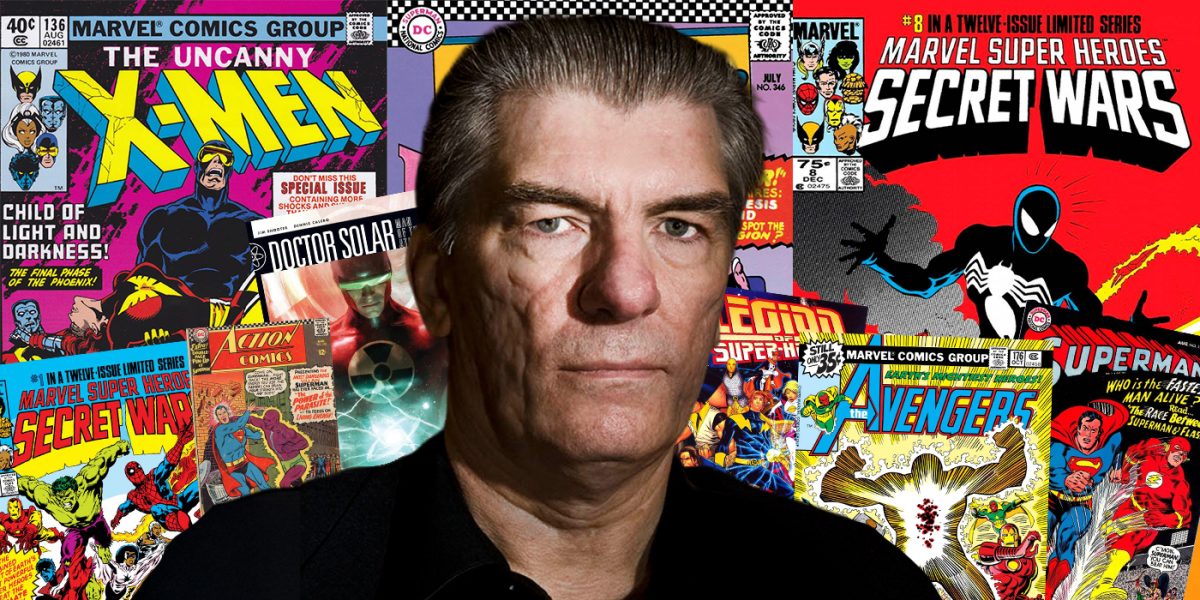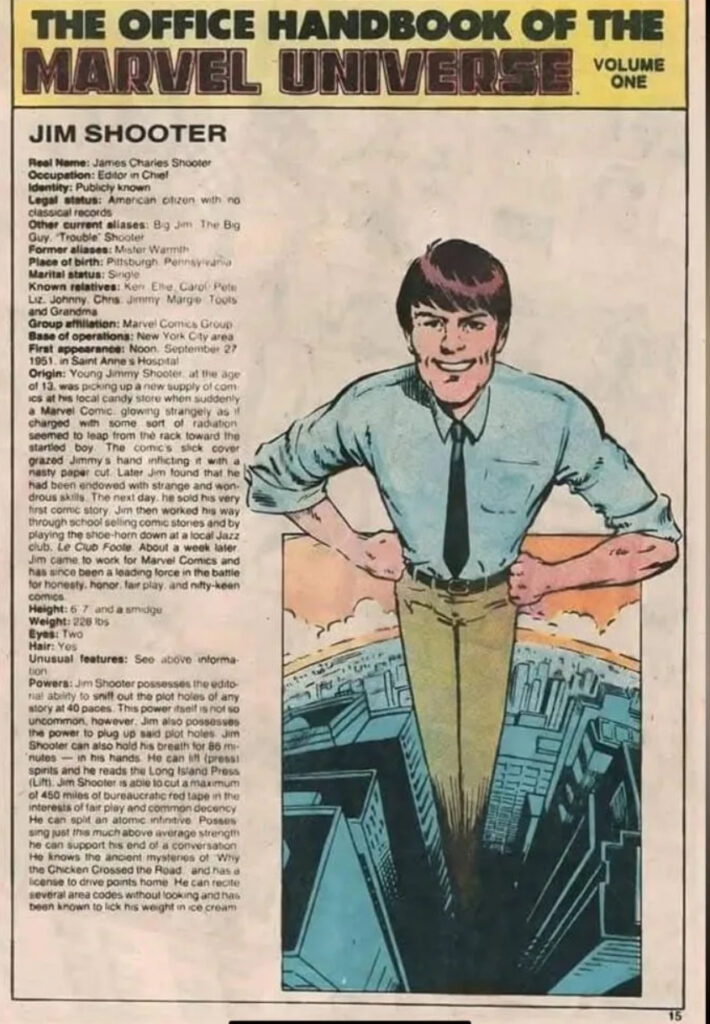


James Shooter passed away from esophageal cancer on June 30 at age 73. One of Marvel’s longest serving editors in chief, Jim Shooter was a competent if controversial executive. Depicted in caricatures in the Bullpen Bulletins as a towering figure who couldn’t fit in panel, Shooter was known for rigid deadlines. Despite clashing at times with creative teams, he managed many long runs now regarded as classics.
Jim Shooter began his career in comics as a young teenager. In the 1960s, DC accepted stories from thirteen year old fans Cary Bates and Jim Shooter on Superman comics. Both young writers would go on to contribute to Superboy and the Legion of Super-Heroes. The new generation of writers incorporated more of the Marvel method of character driven storytelling into DC’s comics. Shooter’s run is noted for featuring surprising character deaths and introducing classic villains like Universo and the Fatal Five. In the middle of a story about Pulsar Stargrave, an enemy mysteriously tied to Brainiac 5, Shooter suddenly left DC for Marvel. Legion artist Dave Cockrum also traveled to Marvel, where he would help create the new X-Men with Len Wein and Chris Claremont.
Jim Shooter came to Marvel during a tumultuous period of the 70s. He has described coming to the offices and offered to write a strange space werewolf comic called Man-Wolf. Instead, Shooter focused mainly on editorial duties. As Marvel went through many writers and editors, Shooter focused on stabilizing the chaos. Less frequent were the fill-in reprints and sudden creative team shifts that characterized previous editors like Gerry Conway. After Stan Lee stepped back from writing and editing, a succession of editors included Roy Thomas, Len Wein, Gerry Conway, Archie Goodwin, and Marv Wolfman. While these editors had lasted only a year or two each, Shooter was in charge for nearly a decade.
During Shooter’s tenure, one iconic run was Walt Simonson’s Thor, which reimagined the Norse god without Don Blake. Another classic run from this period was Frank Miller’s Daredevil, which brought in ninja characters like the Hand and Elektra. Miller’s Daredevil inspired the creation of the Teenage Mutant Ninja Turtles and their enemies the Foot as a Daredevil parody. John Byrne’s emergence as a star artist on titles like X-Men, Fantastic Four, and Alpha Flight occurred under Shooter’s aegis as well. Two of the longest runs in comics, Chris Claremont’s run on X-Men, and Mark Gruenwald’s run on Captain America, began in the Shooter period and continued into Tom DeFalco’s editorship.
One of Shooter’s most enduring creations was the Beyonder. Developing Secret Wars, Shooter made a toy deal to create comics crossovers based on a new superhero vs supervillain toyline. This storyline followed in the footsteps of Marvel crossovers like Contest of Champions and the Avengers Defenders War. Shooter’s unique aspect was creating a godlike being in the Beyonder who used the heroes and villains to judge good and evil. The first Secret Wars series was a self contained 12 issue battle event that introduced the Black Symbiote Costume of Spider-Man, which later became Venom. The Secret Wars comics were the first to feature Magneto as a hero, as the Beyonder grouped him with the superheroes rather than supervillains.
Secret Wars II took things in a strange, philosophical direction. The Beyonder began investigating humanity firsthand, incorporating himself onto Earth. This arc was much more intrusive than the original Secret Wars, inserting the Beyonder into ongoing scenarios. Significant changes occurred to the Marvel Universe during Secret Wars II. Tony Stark reclaimed the role of Iron Man with the new Scarlet Centurion armor. Spider-Man defeated Firelord, his toughest opponent yet. Magneto and Storm took control of the X-Men and New Mutants as Professor X left for space. The Defenders was cancelled after the Beyonder and his disciple Moondragon clashed with them, to make room for X-Factor, a new comic reuniting the original X-Men, including Jean Grey’s first appearance since Shooter demanded she die at the end of the Dark Phoenix Saga. The Beyonder sees Human Torch grapple with a child lighting himself on fire to imitate him in an ironic Byrne Fantastic Four issue. Using the Molecule Man and the Beyonder, Shooter told a bizarre story of mortals and gods clashing. Most future comics crossovers would take their cues from Secret Wars II’s model. DC’s Crisis on Infinite Earths was a line wide crossover resetting continuity, with a core title spilling into the monthly books. Shooter followed up Secret Wars II by overseeing the Mutant Massacre crossover by X-Men’s Chris Claremont, and X-Factor’s Walt and Louise Simonson, which led to further X-crossovers like Inferno after his departure.

Shooter came to be seen as overly intrusive by former allies like John Byrne whose ambitions grew with their reputation. Byrne grew from a well regarded artist to a writer as well. Eventually after writing and drawing Fantastic Four and Alpha Flight for several years, Byrne moved to DC to revamp Superman after the Crisis on Infinite Earths allowed him to revise DC continuity.
Shooter also came into conflict with writer Bill Mantlo over issue #286 of Hulk. This comic was allegedly plagiarized from the “Soldier” episode of the Outer Limits. To compensate Outer Limits writer Harlan Ellison, Marvel gave him a lifelong subscription to their comics. Shooter allowed Mantlo to continue on Hulk for a couple years after this, letting his experimental stories of an intelligent Hulk continue laying the groundwork for the Peter David run. During Secret Wars II tie-ins, Shooter swapped Mantlo and Byrne on Hulk and Alpha Flight. Despite teasing the idea of a body swap between Sasquatch and Hulk, Sasquatch instead came to occupy an albino ape form and the human body of the female Alphan Snowbird. The controversial wasting sickness of NorthStar being revealed as due to his being an elf from Asgard was seen as a cop out by Mantlo to avoid the eventual revelation that he had AIDS in Alpha Flight #106. Under Shooter, Marvel was accused by Byrne of having a policy of not allowing gay superheroes, but the gay civilian character of Arnie Roth in DeMatteis’ Captain America run saw print under Shooter’s watch. Byrne had a brief run on Hulk which was nonetheless significant for marrying Betty Ross and Bruce Banner, as well as separating Bruce and Hulk physically.
In the final phases of Shooter’s tenure, the mystery of the Hobgoblin came to unravel. Shooter had presided over Roger Stern’s well-regarded runs on Avengers and Spider-Man. However, Stern left Spider-Man after Secret Wars. His replacement Tom DeFalco wrote himself into a corner by planting clues heavily implying Hobgoblin was Ned Leeds, and other Spider-Man writers struggled to find another suspect who would make the Hobgoblin reveal a surprise. Spider-Man editor Jim Owsley had Leeds killed in a Spider-Man Vs. Wolverine special to spite DeFalco, then fired him. Owsley was then himself fired by Shooter as editor. Owsley completed drafts of Gang War plotted by DeFalco, but the end result was a confusing crossover infamous for being resolved by Daredevil in a Kingpin fatsuit. Owsley reversed DeFalco’s plan to have Richard Fisk as Hobgoblin, and instead revealed Richard as the Rose. Peter David rejected Owsley’s demand that the Foreigner be Hobgoblin, revealing the Foreigner was instead posing as the policeman Kris Keating. David wrote that the deceased Ned, not Roger Stern’s preferred Kingsley brothers, was Hobgoblin, in Amazing Spider-Man #289. Owsley’s Web of Spider-Man #29 has Kingsley shot, eliminating another suspect. A decade later, Roger Stern would return for Hobgoblin lives, and impose further retcons restoring his original intended culprits, Roderick and Daniel Kingsley.
Shooter meanwhile was pressured by fans and Stan Lee at a comic convention to write a marriage between Peter Parker and Mary Jane. This story was implemented just after the conclusion of Gang War and the sudden end of Peter’s relationship with Black Cat as Felicia was discovered by Peter to be a spy for the Foreigner. Shooter had already stopped Mantlo from allowing Felicia and Peter to have a child to avoid harming merchandising deals’ morality clauses, but now their relationship was forced to end on a sour note. Following the wedding annual by Shooter and honeymoon annual by Owsley, the Spider-Man comics went in a new direction with new writers and editors. David Michelinie would begin a hundred issue run on Amazing, while Gerry Conway returned to Spectacular and Web. In 1987, Shooter was fired, replaced by Tom DeFalco, who had lost Spider-Man but gained Thor and an editor in chief position. One of his last duties as editor in chief was attending the wedding of Peter Parker and Mary Jane at Yankees Stadium.

Shooter was best known for helping turn around Marvel’s core superhero books, but also had several lesser known efforts. The New Universe comic Star Brand about an everyman superhero from “the world outside your window” in Shooter’s hometown Pittsburgh was an attempt by Shooter to modernize superhero comics. Shooter’s run with John Romita Jr. was cut short 7 issues into the series. For the final year of the title, after a few fill-ins by Shooter’s old DC colleague Cary Bates, John Byrne took Star Brand in a different direction, destroying Pittsburgh in the Pitt special. Eventually the Star Brand from the New Universe crept into Earth-616 in Mark Gruenwald’s Quasar, and it has been used in later Avengers comics. Epic Comics, initially developed under Archie Goodwin but continuing under Shooter, allowed creators to do older skewing, code free stories. Shooter also pioneered direct to comics store sales with the titles of disco superhero Dazzler, the schizophrenic Moon Knight, and jungle adventure Ka-Zar.
After his exit from Marvel, Shooter founded other comics companies including Valiant, Defiant, and Broadway. Valiant was known for their licensed Nintendo comics like Zelda and Mario, and featured some early work by creators who would go on to work on Sonic comics for Archie. Valiant also had several new superhero titles by Jim Shooter and Steve Englehart like Shadowman and X-O Manowar, as well as licensed Gold Key heroes Magnus, Robot Fighter, and Solar, Man of the Atom. Under Shooter’s direction, Valiant had a Unity crossover between 9 of their comics in 1992. In 1993, Shooter’s Defiant was a short lived studio most known for producing Warriors of Plasm, which provoked a lawsuit from Marvel. A crossover intended to be of Secret Wars II called Schism was cancelled two issues in due to legal troubles faced at Defiant. Broadway was a brief attempt by Blockbuster video to create a comics line focused around the character Fatale until it was sold to Golden Books.
Shooter later returned to DC for a final run on Legion of Super-Heroes in the 2000s. He wrote the final year of the Threeboot continuity, following Mark Waid’s reset of Legion continuity. After Shooter’s run, Legion continuity including Shooter’s original characters, was restored in later Legion runs by Paul Levitz. Legion continuity was once again rebooted by Brian Michael Bendis several years after Levitz’s final run. Many of Shooter’s Legionnaires and villains still exist in modified form in current DC continuity.
Shooter’s career in comics was not without controversy, but not without achievement either. The period of his editorial control produced some of Marvel’s strongest work. Did you read Shooter’s comics? Leave a comment on this article on the ToonZone forums.
The post Retrospective: Jim Shooter: A Life in Comics appeared first on Anime Superhero News.